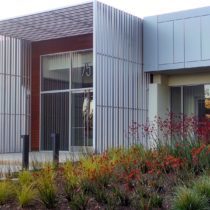Landscape Architecture for Landscape Architects › Forums › GENERAL DISCUSSION › Netafim Techline vs. Rainbird XFS
- This topic has 1 reply, 5 voices, and was last updated 10 years, 1 month ago by
 Goustan BODIN.
Goustan BODIN.
-
AuthorPosts
-
February 18, 2014 at 2:51 am #153094
 Charles RichisonParticipant
Charles RichisonParticipantI work for a small residential landscape architecture firm. We are in the process of converting our drip irrigation from the standard 1/2 tubing with 1-2gpm emitters to a subsurface drip system for shrub and groundcover areas. We’ve talked to the product reps for both Netafim and Rainbird. I’m looking for insight from anyone who has used one or both of these products. Is one product easier to install? Is one product more durable or have less typical long term maintenance? How does the quoted water efficiency relate to the actual installed product? Any feedback would be greatly appreciated.
February 19, 2014 at 3:37 am #153098 Goustan BODINParticipant
Goustan BODINParticipantif you’re on Linked-In, I’d recommend you ask your question in that group :
February 19, 2014 at 3:28 pm #153097 tobyParticipant
tobyParticipantI’m not sure there is much of a difference between the two. And IIRC, RB marketed Netafim for a while way back and then Netafim managed to establish a niche market in the US. Both use a variety of barbed fittings to make the network in any layout imaginable.
Netafim I installed in middle 90s is still in use at many clients houses. One has 17yo netafim in his veg garden and it gets moved around every year. It’s tough if you take care of it. Many times the selling point was stopping the damaging overspray on house walls.
I have a contractor that installs it regularly, preferring it in plant beds over sprinklers because of shadow problems. He typically buries it an inch below the soil surface even if using a mulch cover.
The biggest problem is not accounting for low spots or sloped terrain by either the designer or the contractor. Just like every other irrigation system, when the valve is off, it will drain at the low point(s). I’ve used low psi check-valves both inline and to make smaller layouts in a single bed to reduce the draining at one location.
Spec the tube on center spacing and stagger the outlets when installing.
What is also nice is being able to add the 1/4″ inline drip tube at any location for things like pots or the one plant that might have higher water needs than surrounding plants. Both drip tubes are compatible and the only issue is accounting for the difference in gph.
Also, consider who the end user is. Clients and maintenance needs to know it exists, and to scrape the area back a bit if they go to plant something. The stuff is easily cut by a sharp shovel or pick. Make sure they have a few straight couplings on hand to make repairs.
March 4, 2014 at 4:07 am #153096 Wes Arola, RLAParticipant
Wes Arola, RLAParticipantToro DL2000 is what we spec. They offer a drip zone valve kit with filter and all included in one product number which is convenient.
March 4, 2014 at 8:00 pm #153095 Nikolaos MillerParticipant
Nikolaos MillerParticipantI have installed both products and their ease of installation are pretty similar, ie both are pretty pliable and don’t kink as easily as some other brands of drip tubing. The XFS doesn’t have check valves built into each emitter like the Netafim dripline does so you need to use an air-relief at the high point of the dripline so the upper emitters don’t suck dirty water back into the line after the zone runs. Using the XFCV dripline would negate that and I think that the in-emitter checks are supposed to hold several more feet of head than the Netafim drip-line does.
If it’s at all possible I would avoid going subsurface in shrub areas as it’s easier to check to see if the zone’s working and less prone to getting cut by gardeners digging around.
-
AuthorPosts
- You must be logged in to reply to this topic.

